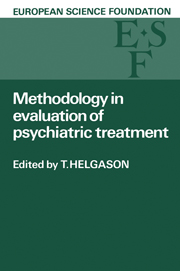 Methodology in Evaluation of Psychiatric Treatment
Methodology in Evaluation of Psychiatric Treatment Book contents
- Frontmatter
- Contents
- Participants
- Foreword
- Preface
- INTRODUCTION
- I METHODS OF CLASSIFICATION
- Principles of ‘Multiaxial’ Classification in Psychiatry as a Basis of Modern Methodology
- Standardized Methods of Classification of Mental Disorders
- The Significance of Biological Factors in the Diagnosis of Depressions
- II EVALUATION CRITERIA
- III RATING METHODS IN EVALUATION OF TREATMENT
- IV OTHER QUANTITATIVE METHODS OFEVALUATION OF TREATMENT
- V ETHICALAND PRACTICAL PROBLEMS
- Index
The Significance of Biological Factors in the Diagnosis of Depressions
from I - METHODS OF CLASSIFICATION
- Frontmatter
- Contents
- Participants
- Foreword
- Preface
- INTRODUCTION
- I METHODS OF CLASSIFICATION
- Principles of ‘Multiaxial’ Classification in Psychiatry as a Basis of Modern Methodology
- Standardized Methods of Classification of Mental Disorders
- The Significance of Biological Factors in the Diagnosis of Depressions
- II EVALUATION CRITERIA
- III RATING METHODS IN EVALUATION OF TREATMENT
- IV OTHER QUANTITATIVE METHODS OFEVALUATION OF TREATMENT
- V ETHICALAND PRACTICAL PROBLEMS
- Index
Summary
Biochemical Variables
Biological factors of an aetiological and of a pathogenetic nature
Diagnosis is the sensible classification of disease symptoms and their causes. I emphasize ‘sensible’. A sensible classification is one that leads to more or less reliable conclusions about the type of treatment to be instituted and about the prognosis of the disease.
Do we know of biological factors of significance in the diagnosis of depressions? The answer to this question is a cautious ‘yes’, adding that prospects seem promising. Before I elucidate this, a few remarks may be made about the restrictions I impose upon myself.
Biological factors can contribute to the development of behaviour disorders in two fundamentally different ways. To begin with, they may be part of what I call the pathogenesis of a given syndrome. I define pathogenesis as the complex of cerebral prerequisites for the development of disturbed behaviour: in other words, as the constellation of cerebral functional disturbances which make disturbed behaviour instrumentally possible (van Praag 1969, 1971). Causative factors of a pathogenetic nature are, therefore, biological factors by definition.
Secondly, biological factors can contribute to the development of the pathogenetic process. Examples are: a traumatic head injury; a primarily extracerebral disease with a secondary influence on certain cerebral functions; a primordially marginal enzyme system. The factors that give rise to the pathogenetic process are what I call aetiological factors. They are of heterogeneous ‘substance’, and may be of a biological as well as of a psychological or psychosocial nature.
I do not intend to discuss biological factors of an aetiological nature, for their diagnostic significance is self-evident. In a case of hyperaestheticemotional symptoms it is important to know whether there is a history of head injury; in a case of depressiveness and apathy we want to know whether the thyroid is hypofunctional. These are two examples among many. I confine myself to biological variables of (suspected) pathogenetic significance.
A second restriction is that I confine myself to chemical variables, leaving physiological variables undiscussed. This paper focusses on biochemical variables, while hormonal variables will be discussed in part II.
Points of crystallization
Until now the ‘central monoamine (MA) metabolism has been the focus of research into biochemical determinants of depressive behaviour. The reason is that the traditional antidepressants - tricyclic compounds as well as monoamine oxidase (MAO) inhibitors - increase the availability of MA at the central neuronal receptors.
- Type
- Chapter
- Information
- Methodology in Evaluation of Psychiatric TreatmentProceedings of a Workshop Held in Vienna 10–13 June 1981, pp. 93 - 120Publisher: Cambridge University PressPrint publication year: 1983


